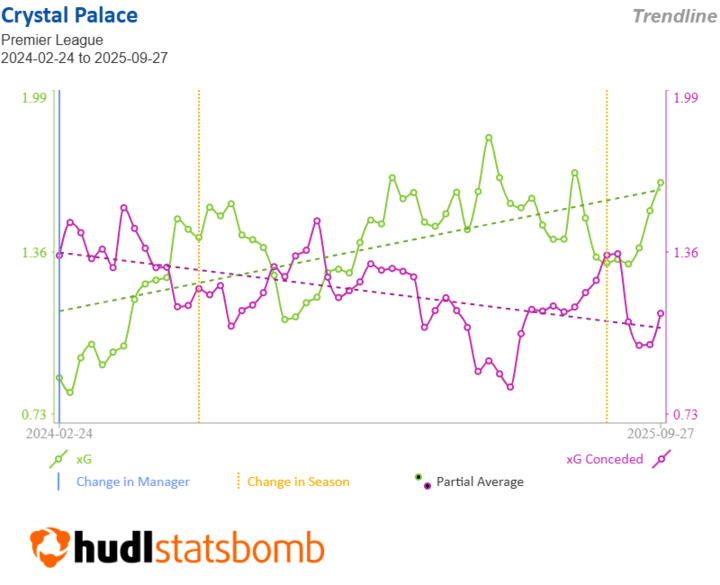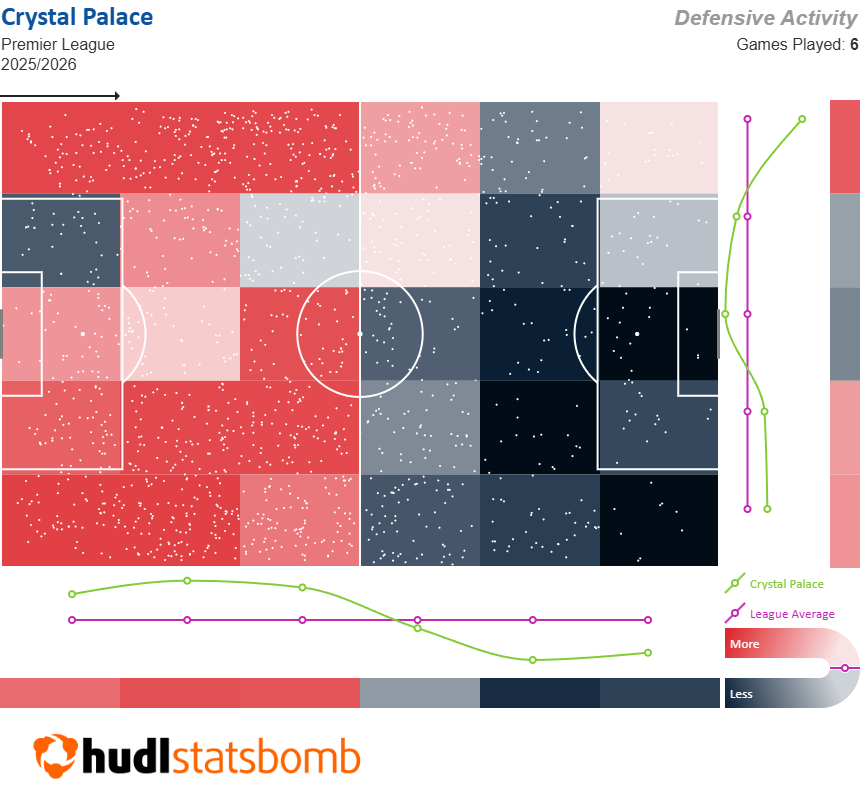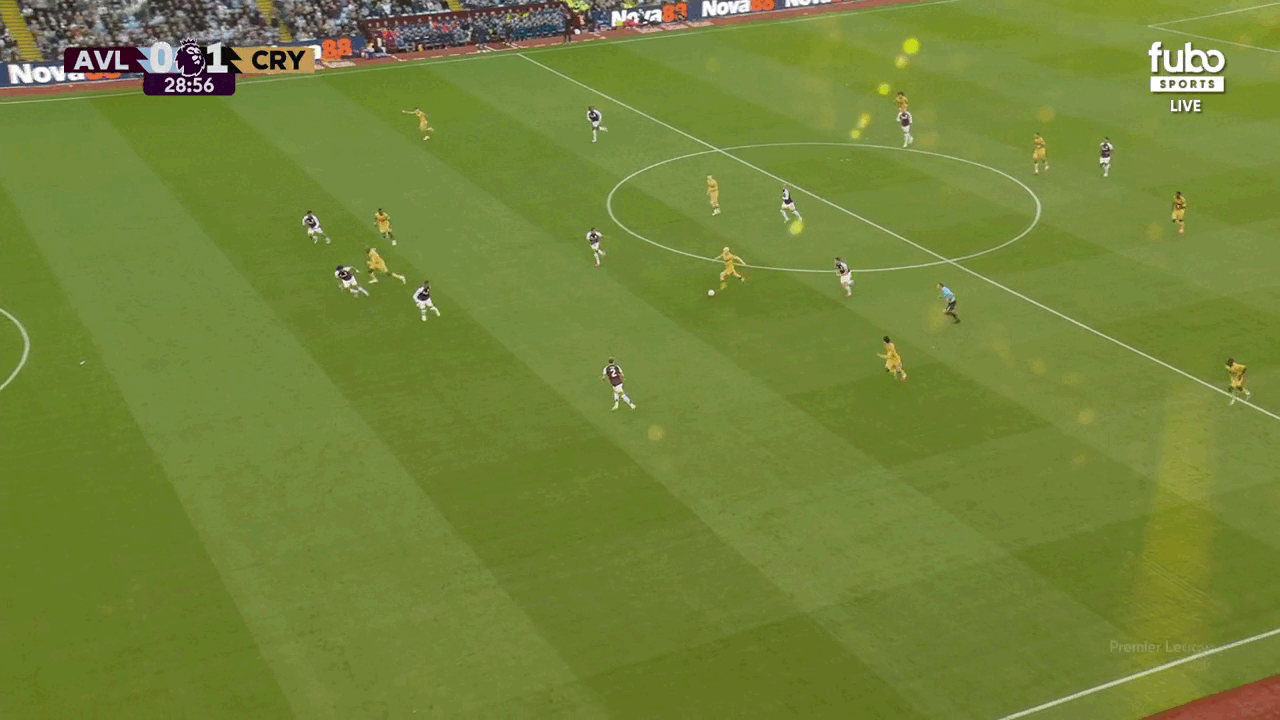- The Transfer Flow
- Posts
- Unique style setting up Crystal Palace for sustained success
Unique style setting up Crystal Palace for sustained success
Their table position is no fluke, and Oliver Glasner's stock is soaring.
It’s a good time to be a Crystal Palace fan. Even the most optimistic within the fanbase wouldn’t have guessed they’d be third in the table six games into the season. Dating back further to the beginning of 2025, they’ve accumulated 45 points from their last 25 Premier League matches with a plus 12 goal difference to boot. A 68 point pace over the course of a full season would be enough to credibly challenge for a Champions League spot, an astounding achievement if completed considering they have one of the lowest wage bills in the league. There’s also the continued euphoria from Palace’s 2025 FA Cup victory, and their current voyage into Europe through the Conference League.
The macro results in terms of points and goal difference during this stretch have been impressive, but the underlying numbers look strong as well. Depending on the expected goal model utilized, Palace are also in the top 3 in expected points through six matches. Their expected goals for and against trendlines since Glasner took over in late February 2024 resemble a squad who is contending for a European spot. It’s the kind of heights which were never reached under previous managers like Patrick Vieira and Roy Hodgson.

One can certainly argue that the out of possession work has been key to Palace’s success. Even though Oliver Glasner spent time in the Red Bull coaching sphere, which stresses front foot football when defending, that’s not necessarily been the case here. Metrics which try to quantify a team’s aggressiveness when defending had them close to the bottom last season and also in 25-26. This includes passer per defensive action (20th this season, 16th in 24-25), and defensive distance (19th, 18th). According to Opta Analyst, they’re currently last in high turnovers (number of sequences that start in open play and begin 40m or less from the opponent's goal) and tied for 4th last in shots generated from high turnovers.
Instead, through a compact 5-2-3 shape when defending, the front 3 is narrow to try and cut off penetrative passes through the middle. Meanwhile, the midfield and backline jump situationally to cut down space and time on opponents receiving through the middle. If it’s one of the wingbacks tasked with closing out, one of the center-backs shifts wide from the initial +1 advantage to create a makeshift backline. Against teams utilizing a static midfield, the setup can be effective. It’s no surprise that after five matches, Opta Analyst had Palace spending the most time in a mid-block. A look at their defensive activity further illustrates when they spring into life.

This helps feed into the ethos of the attack, which is direct and at a high pace. Glasner himself has mentioned how important speed is in progressing play into the opposition half. You can see it during different phases of play, including how quickly Palace look to restart from free kicks in the middle third. Opta Analyst had them with the 4th highest direct speed last season at 1.89 m/s, and that’s jumped up to 1st this season at 2.11 m/s. Whenever they do get into the final third, no other team has been as efficient in manufacturing quality shot attempts.
Another (too early) look at PL Attack Efficiency
-Palace far better than the rest, City not far behind
-Arsenal and Spurs taken a dip since MW 2
-Everton starting strong
-Bmouth high on quantity but not quality
-Forest joins Villa at bottom of the pack— NL (@ftblnl)
3:23 PM • Sep 25, 2025
A major part of Palace’s ability to thrive in chaotic situations is the willingness to hunt for space off the ball. At their best, there’s an almost automatic feel for how they’re able to turn a recovered loose ball inside their own half (especially near the halfway line) into a dangerous attack. Adam Wharton in particular is proficient at quickly feeding passes towards the forward line within his first two touches. Having someone like him spray outlet passes immediately following a loose ball recovery empowers the front line to get into high gear.
Once the possession sequence approaches the final third, something that becomes quite clear is the spacing they utilize when attacking the penalty box. Tyrick Mitchell has steadily improved as an attacking threat on the ball, including near-post crosses and cut-backs. He becomes a credible threat to create chances after utilizing underlapping runs into the left side of the box. On the opposite side, Daniel Muñoz is great at crashing the area and has more variety with his movement than you’d expect from a wingback.
The forwards are crucial in these situations. Jean-Philippe Mateta and Ismaïla Sarr have shown to be quite adept at playing off each other’s movement and occupying different spots while stretching the opposing backline. Outside the box, one will drop while the other looks for space in behind. Once they’re in the 18 yard area, and especially when attacking with pace, they constantly force the opposition defenders to pick their poison by tracking different runs. Below is an example of Mateta and Sarr diverging towards opposite posts, as the latter misses a headed opportunity from close range.

The first 45 minutes versus Liverpool was close to the absolute best case for Palace’s game plan. Admittedly, Liverpool’s wonky setup played into their hands, but they were constantly on the backfoot while Palace broke out at breakneck speed. The fast break at 2:59 from Daichi Kamada dispossessing Ibrahima Konaté was maybe the standout sequence from a first half chalk full of chances.
A consequence of the way Crystal Palace play is they’re not a side which can progress play in a measured manner. You’ll see them try a few ideas in buildup, including moving Jefferson Lerma from the pivot towards the flank and bringing the 10s deeper when faced with man-to-man marking. This happened constantly versus Sunderland to varying degrees of success. If anything, an argument can be made that Palace’s best buildup method being simply firing passes towards Mateta, whether it be towards his feet or long balls. He’s not the most prolific in terms of aerial duels, although he certainly will battle the CBs. Rather, it’s very hard to dispossess him when receiving ground passes due to how he shields the ball.
In matches where they have more than a 50% share of possession, the dynamics are much different. No team created less buildup attacks last season (open play sequences that contain 10 or more passes and either ends in a shot or has at least one touch in the box) than Palace according to Opta Analyst, and so far in 25-26, they’re tied for 6th from bottom. Although they don’t have to take the initiative in many matches over the course of a season, it is a flaw worth pointing out.
All that said, we are nearing a calendar year of this game model from Crystal Palace being successful. Their recipe consists of a mid-block with opportunistic jumping to maintain the bend but don’t break structure, quick outlet passing towards the feet of their talented attackers, and coordinated off-ball movement and top notch motor. It’s a unique formula which allows them to have moments of high-octane football. Given the personnel Glasner has to work with, few would argue he’s not done well under the circumstances.
Glasner’s name has been mentioned as a possible candidate for big managerial jobs, with Manchester United in particular. It’s not hard to see why when considering the struggles under Ruben Amorim, and both managers utilizing a back 3/5 framework. They’re not the only rich club to be linked with the Austrian manager; Bayern Munich pursued him following the conclusion of the 23-24 season. Football clubs are constantly on the hunt for managers who can help maximize the available talent at their disposal. Glasner fits the bill, at least on the surface. Going back to his time in the Bundesliga when he led Wolfsburg and Eintracht Frankfurt, he helped them overachieve in both the league and cup competitions.
The question is whether predominantly defending just inside your own half, and then pushing forward at breakneck speed to avoid going against a set defense, scales up towards big clubs who have bigger resources at their disposal. As recently as 2-3 years ago, the answer would be no. The best PL sides were obsessed with control through a methodical approach. One example was the rise of the box midfield in different variants to have an advantage in the midfield. As a result, opponents would be pinned in their own third and concede lots of chances.
However, there’s been a greater embrace of verticality at the highest level of English football. The return of heavy man-to-man marking during pressing situations has brought about a greater willingness to play direct, shifting the tactical meta. It’s helped jumbo strikers make a triumphant return as both direct outlets and also pinning opponent backlines via constant runs in behind. The joke in niche online football circles is of the Premier League resembling a richer version of the Bundesliga. In some ways, Crystal Palace under Glasner are a shining example of the new environment we’re in. However, they don’t take it to opponents out of possession in a way that clubs like Bournemouth have under Andoni Iraola.
Could Glasner maintain a high level of coaching impact embracing a more proactive approach both in and out of possession? One could be skeptical of such a scenario occurring, although there is always the possibility. The hiring of Thomas Frank by Tottenham Hotspur may provide an interesting test case for what could happen. Having helped Brentford punch above their weight in the Premier League by constantly winning on the margins, he’s now moved up the football food chain and has been tasked with coaching a Spurs side that needs to take the initiative more often. So far, results have been mixed, although we’re super early into his tenure. Frank being hired in of itself might mean someone else ends up taking a similar bet with Glasner in the not too distant future.
Further discussion of such a scenario is for another time. For now, Palace are flying high and are in almost uncharted territory. The early 1990s remains the high water mark for them in the first division of English football. Outside of that, it’s not a stretch to say 2025 represents the most sustained run of success the Eagles have had. The next handful of Premier League matches will be a thorough test due to the vastly different game models from the likes of Everton, Bournemouth, and Arsenal. All the while, the demands of European football will start to kick in, which in the past has led to wonky PL campaigns from non-big six clubs. Those factors may lead to an end of this gravy train, and if so, a 18 match unbeaten streak which included a domestic trophy is certainly a great accomplishment. If the good times still are going into the November international break, then we might start talking about this Crystal Palace run with even greater reverence.
If you enjoyed this newsletter, we’d appreciate it if you would forward it to a friend. If you’re that friend, welcome! You can subscribe to The Transfer Flow here. We also have a podcast where we go in depth on transfer news and rumours every week. We’re on YouTube here, and you can subscribe on Apple Podcasts or Spotify by searching for “The Transfer Flow Podcast.” If you’re interested in football betting, check out this post on why we started Variance Betting.